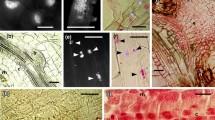Abstract.
Camptothecin, a topo isomerase-I inhibitor used in cancer therapy, induces apoptosis in animal cells. In tomato (Lycopersicon esculentum Mill.) suspension cells, camptothecin induces cell death that is accompanied by the characteristic nuclear morphological changes such as chromatin condensation and nuclear and DNA fragmentation that are commonly associated with apoptosis in animal systems. These effects of camptothecin can effectively be blocked by inhibitors of animal caspases, indicating that, in tomato suspension cells, camptothecin induces a form of programmed cell death (PCD) with similarities to animal apoptosis (A.J. De Jong et al. (2000) Planta 211:656–662). Camptothecin-induced cell death was employed to study processes involved in plant PCD. Camptothecin induced a transient increase in H2O2 production starting within 2 h of application. Both camptothecin-induced cell death and the release of H2O2 were effectively blocked by application of the calcium-channel blocker lanthanum chloride, the caspase-specific inhibitor Z-Asp-CH2-DCB, or the NADPH oxidase inhibitor diphenyl iodonium, indicating that camptothecin exerts its effect on cell death through a calcium- and caspase-dependent stimulation of NADPH oxidase activity. In addition, we show that ethylene is an essential factor in camptothecin-induced PCD. Inhibition of either ethylene synthesis or ethylene perception by L-α-(2-aminoethoxyvinyl)glycine or silver thiosulphate, respectively, blocked camptothecin-induced H2O2 production and PCD. Although, in itself, insufficient to trigger H2O2 production and cell death, exogenous ethylene greatly stimulated camptothecin-induced H2O2 production and cell death. These results show that ethylene is a potentiator of the camptothecin-induced oxidative burst and subsequent PCD in tomato cells. The possible mechanisms by which ethylene stimulates cell death are discussed.
Similar content being viewed by others
Author information
Authors and Affiliations
Additional information
Electronic Publication
Rights and permissions
About this article
Cite this article
de Jong, A.J., Yakimova, E.T., Kapchina, V.M. et al. A critical role for ethylene in hydrogen peroxide release during programmed cell death in tomato suspension cells. Planta 214, 537–545 (2002). https://doi.org/10.1007/s004250100654
Received:
Accepted:
Issue Date:
DOI: https://doi.org/10.1007/s004250100654



